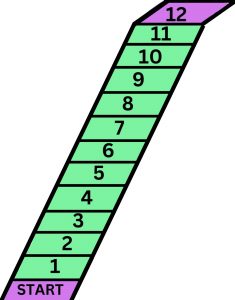DIVISIBILITY GAME
The only resources needed are 2 dice and pencil and paper for scoring. Decide the divisors for your game, say 3 and 5. Throw 2 dice and choose between two 2-digit numbers (unless it’s a double) e.g. with 5 and 6 choose 56 or 65. Score 1 point if your number is divisible by 3 or 5, 2 for divisibility by a square of 3 or 5, and 3 for divisibility by a cube of 3 or 5 etc. For example :
- 64 and 46 are not divisible by 3 or by 5, so this throw scores no points.
- 12 and 21 are both divisible by 3 but not by 5, so whichever the player chooses, the score is 1.
- 15 is divisible by 3 and 5 so it scores 2 points.
- 51 is divisible by 3, but not by 5 or 9 so it scores 1 point.
- 36 and 63 are both divisible by 9 so they both score 2 points.
 Use the ladder and counters to record scores. It’s wide enough for 2 on the same step. One counter can go past another. Counters are blocked by a step with 2 counters on it, and may lose points, or even lose a turn.
Use the ladder and counters to record scores. It’s wide enough for 2 on the same step. One counter can go past another. Counters are blocked by a step with 2 counters on it, and may lose points, or even lose a turn.
Other variants of the game played using the same rules include TWOS AND THREES or TWOS AND FIVES or TWOS, THREES AND FIVES or SEVENS AND ELEVENS . You will find that, when 2 is included, you quickly score more points, so you could play that you need 24 points to win, or even 36 points. Other variants include divisibility by 13 using any two or three, four, five or six of the prime numbers from 2 to 13.
THREE DICE VARIANTS: Playing any of these games with 3 dice, and 3-digit numbers, will be even more challenging. The same rules are used and you score according to the power of the number used in the game that divides the number thrown on the dice.
Click here to download the DIVISIBILITY gameboard.
South Africa COVID-19 News
Here is the official website for COVID-19 updates.
Login
SUPPORT AIMSSEC





